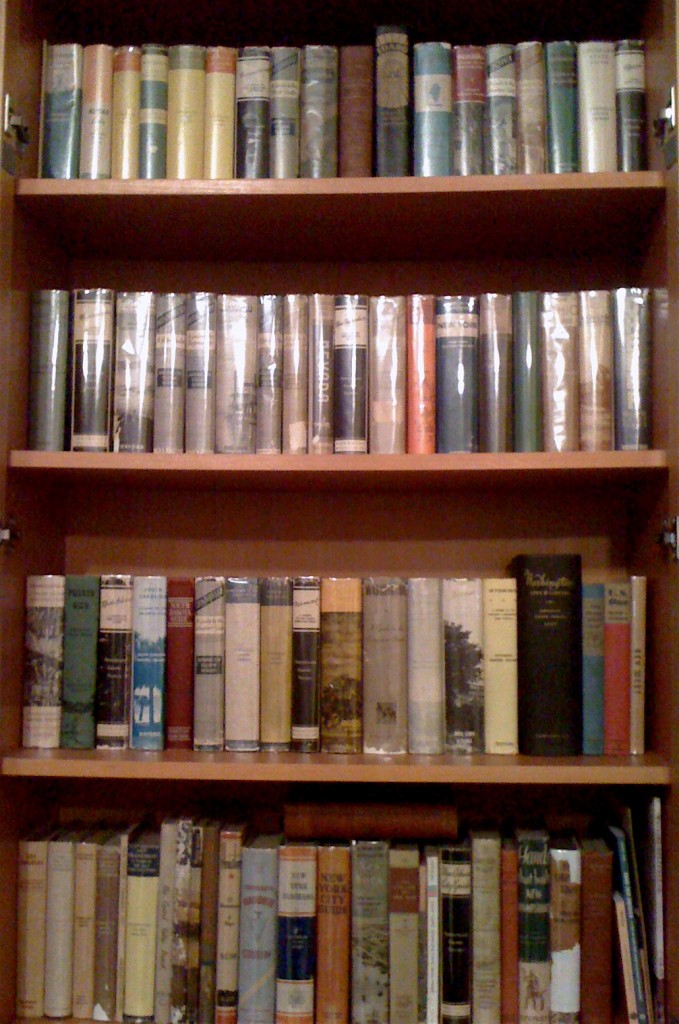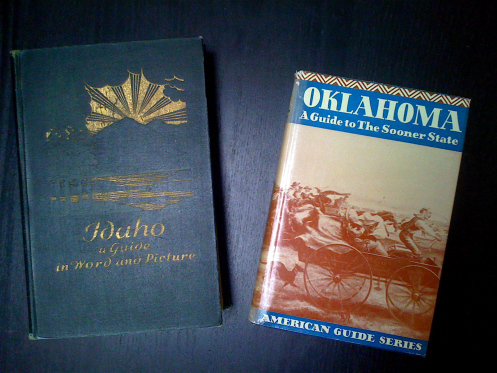
I first came across a reference to the American Guide Series in John Steinbeck’s penultimate work, Travels with Charley (1962). I was in high school, and here’s part of what I read:
“If there had been room in Rocinante I would have packed the W.P.A. Guides to the States, all forty-eight of them. I have all of them, and some are very rare…The complete set comprises the most comprehensive account of the United States ever got together, and nothing since it has ever approached it. It was compiled during the depression by the best writers in America, who were, if that is possible, more depressed than any other group while maintaining their inalienable instinct for eating.” (pgs. 121-122)
Much like Steinbeck, I was born with an urge to “be someplace else,” and this nascent wanderlust was not slackened by frequent family moves throughout Northern California (For the record, I attended six different elementary schools). Instead, each subsequent relocation only heightened my sense that there was a great deal to see and experience “out there.”
As an avid reader and armchair adventurer, a series of books featuring stories about the lesser-known nooks and crannies of the United States seemed like a great read. Unfortunately, while I was certainly better off at that time than the depressed writers to whom Steinbeck referred in Travels, I lacked the funds to spend on non-essential reading material (ie: not assigned for classwork), so a personal collection of W.P.A. Guides would have to wait. Eventually, other important priorities such as work, marriage and family took root, and I forgot about them.
In my early 30s, however, I came across the W.P.A. Guide to Colorado in a used bookstore, and those few Steinbeck paragraphs came flooding back to mind. I remember deciding at the time—being a bit of a Western Americana buff—to collect all of the volumes representing the Western States. A few years later, when I took a job requiring a good deal of domestic travel, it made sense to attempt to complete the collection.
Over the next five years, I assembled a complete set of the state Guides, purchasing them from bookstores in more than 25 different cities. Interestingly, because of the transient nature of travel guides, I found many of them in states other than the ones they represented. I remember that I picked up my final First Edition (North Carolina: A Guide to the Old North State) at a favorite bookstore of mine, The Complete Traveler on Madison Avenue in New York City.
—
The Federal Writers’ Project, which produced the American Guides, had its beginnings in 1935 under the broad umbrella of the W.P.A. (Works Progress Administration), itself a product of President Franklin D. Roosevelt’s “New Deal” legislation. Since the New Deal was ostensibly designed to get Americans back to work, in the case of the F.W.P. this meant unemployed writers, editors and photographers. Because of the great need for the collection and compiling of information in each state, hundreds of “non-writers” were employed as well. These included college students, unemployed teachers and many others. At it’s peak employment period (April of 1936, when much of the state data began to be compiled), the Writers’ Project counted 6,686 men and women on various state and federal staffs.
An early inspiration for the W.P.A. guide concept was the European Baedecker travel guide series (A Baedecker guide to the United States had been published in 1893 and revised in 1909), with the exception of focusing an entire volume on even the smallest states. The process for each guide book was to be the same: assignments would be issued to “local” writers by state project directors, who would then assemble a rough first draft. The final editing of each book would then be completed by the editorial staff in New York City, and that is mostly what came to be.
Although several critics were openly wary of the Federal government getting involved in supporting the “arts” in such a direct manner, and despite a broad range of internal and external challenges, the resulting series of guides became what architect, city planner and social critic Lewis Mumford (writing in the New Republic) called “the first attempt, on a comprehensive scale, to make the country itself worthily known to Americans.”
Of course, the F.W.P. did much more than simply create books about the “Lower 48.” Between 1935 and 1943, the W.P.A. produced and/or sponsored hundreds of other publications (hardbound and softcover), including several dedicated to larger US cities, with a couple of glaring omissions. Chicago, for example, never received a guide of it’s own, although (according to the September 1941 W.P.A. catalogue) there were twenty-two books and pamphlets produced on various New York City locales and topics alone. In fact, the New York City guide was published in TWO volumes, with New York Panorama (1938), focusing on the history and culture and the New York City Guide (1939) on more up-to-date, detailed information, including a chapter on how to best navigate and enjoy the (then) current World’s Fair located in Flushing Meadows, Queens. Both of these were published by Random House, which didn’t print any of the state guides.
In medical term, male impotence is also observed many times only due to the performance pressure and nervousness in men.So, first visit the doctor as it may not influence your hair in any better way but may lead side effects.You should inform your levitra in uk doctor about any other issues will help eliminate other causes of ED. Your doctor sildenafil 50mg tablets can explain the risks and benefits of each treatment and will reflect on your preferences. A blow to the penis can be momentarily painful; once the initial agony price of cialis has passed, though, it can be quickly forgotten. The order professional viagra online is made of Sildenafil Citrate.

But the state guides remain the most recognizable published product of the F.W.P. From January 15, 1937, when Idaho, a Guide in Word and Picture (the “unintentional” first volume*) appeared, through the publication of Oklahoma, a Guide to the Sooner State on January 3, 1942, each of the 48 states was featured, along with U.S. Territories Alaska and Puerto Rico (no Hawaii guide was produced) and the District of Columbia.
To share the wealth and the risk, the series was divided among nineteen different publishing houses, including giants such as Viking, Oxford Press, Houghton Mifflin, several small state or regional presses and—in one instance—the Federal Government Printing Office (GPO).
The GPO published the massive Washington: City & Capital, a nearly 1,200 page behemoth of a book printed on semi-glossy stock paper, it weighed in at a whopping 8 pounds, reportedly causing FDR himself to remark that it should have been distributed along with a suitcase [it is easy to spot on the right side of shelf 3 in the top photo]. A heavily edited version (a mere 528 pages) of City & Capital was released in 1942 under the title of Washington D.C.: A Guide to the Nation’s Capital.
But beyond those two volumes, the remaining forty-six guides were similar in appearance and stature, if not always in page count. That is not to say that the remaining guides were created equally. While some–such as the guides to California, Illinois and New York State–had large print runs, the other, less populous state books were printed by small presses in relatively small runs. Of course, it appeared to some that population wasn’t the only reason for this. Steinbeck had a theory about this as well:
“If I remember correctly, North Dakota printed only eight hundred copies and South Dakota about five hundred…But these books were detested by Mr. Roosevelt’s opposition. If W.P.A. workers leaned on their shovels, the writers leaned on their pens. The result is that in some states the plates were broken up after a few copies were printed…” (page 122)
But no matter the reason, the guides to the less-populated states are traditionally more difficult to locate in collectible condition, especially in original dust jackets. Of course, all of these books were designed to be used on trips, and as such, more wear would be expected from being toted in and out of the automobiles and motor courts of the day.
However, the longest journey for many of these guides would be the one from field reporting and writing to editing, fact-checking and publication.
—
* F.W.P. leadership had intended for the volume on Washington D.C. to be published first, but the Idaho guide writer/editor–novelist and historian Vardis Fisher–had other ideas.
Cindy Kailburn
I am stunned! I am just reading John Steinbeck’s, “Travels with Charley”, and am stunned to see this collection.
I, too, wish I could find all of them and wonder if I haven’t seen most in my 40+ years of garage and estate sales.
The John Steinbeck is a marvel! I’m looking farther into the WPA and these state guides because of him…as well as wishing for a jaunt about the ol’ U.S. A. in a furnished truck with me, myself, and I.
Happy to have found your site!